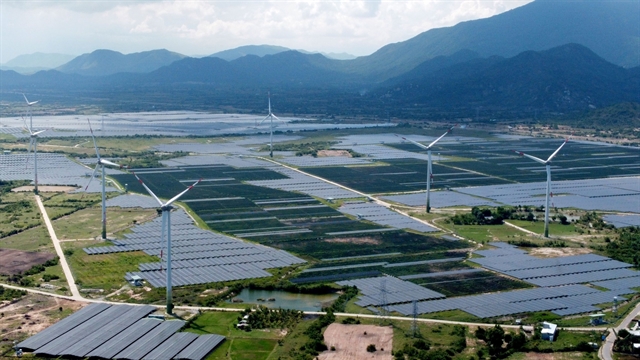 |
| Investment funds keeping a close eye on the country’s renewable energy sector for potential investment opportunities. — VNA/VNS Photo |
HÀ NỘI — Investment funds are currently focusing on capitalising on opportunities in sectors that exhibit robust resilience or the ability to go against the cycle.
All signs currently indicate a continued withdrawal of funds from Southeast Asia exchange-traded funds (ETFs).
SSI Research experts maintain a cautious stance on the flow of capital into Vietnamese ETFs, however, the outflow intensity is expected to be more limited compared to the previous quarter.
“Positive indicators may start to appear as the macro-environment (including exchange rates and interest rates) or political stability improves. In particular, Việt Nam could benefit as profit-taking trends and opportunities for alternative investments emerge in the Taiwan market,” SSI Research said in a statement.
In July, ETFs saw ongoing capital outflows totalling VNĐ2.33 trillion (US$93.5 million), accounting for 3.5 per cent of total assets.
Since the beginning of the year, ETFs have experienced cumulative net outflows of VNĐ18.5 trillion, equivalent to 24.4 per cent of total assets by the end of 2023, reducing total ETF assets to just VNĐ59.9 trillion.
Overall, following a choppy July (especially towards the month’s end), capital inflows into equity funds are likely to be more cautious in August, evaluating the risk of a market downturn in the US.
SSI Research remains cautious following the dissolution of the iShares Frontier Fund in Việt Nam by Blackrock, a leading asset management group, at the beginning of June.
With a total value of $425 million, the iShares Frontier Fund had the highest allocation to Vietnamese stocks at 28 per cent.
According to data from BSC Research, after the announcement, between June 7 and June 18, the fund sharply decreased its exposure to Vietnamese stocks from 28 per cent to 13.77 per cent, representing about $50.22 million remaining.
Foreign investment funds and investors play a crucial role in the Vietnamese stock market’s institutional investor landscape. However, the group has been consistently reducing their positions since 2023.
Specifically, foreign investors have net sold $2 billion since the beginning of 2024. Taking into account data from 2023, their net sales amount to around $4 billion.
Nguyễn Quang Thuần, Chairman of FiinGroup, said that foreign investors are selling off assets and exiting emerging markets due to doubts about a potential interest rate cut by the US Federal Reserve.
Meanwhile, Chairman of Dragon Capital, Dominic Scriven, said that part of the reason for this trend is Việt Nam’s lack of market status upgrade and new compelling factors.
Flexible risk management
Amid State divestments in various firms, significant opportunities exist to attract more institutional investors domestically and internationally. Investment funds are adaptable across all scenarios.
VinaCapital, for instance, closely monitors macroeconomic and political trends to adjust investment strategies, favouring sectors with resilience or counter-cyclical potential.
A notable development in July was the Ministry of Finance’s proposal to permit foreign institutional investors to engage in T+2 trading with brokerage support. It is expected that in the fourth quarter, this regulation could prompt foreign funds to return to the Vietnamese market.
Experts at investment funds are also closely eyeing the potential in renewable energy and tech sectors, offering growth prospects independent of traditional economic cycles amid global flux.
VinaCapital notes Việt Nam’s appeal to global investors, expecting an influx of $25 billion in new foreign capital into Vietnamese stocks by 2030, upon the market’s upgrade.
Nevertheless, the country remains sensitive to global shifts, prompting VinaCapital to prioritise risk management in its investment strategy going forward.
VinaCapital employs a comprehensive risk management process, starting with meticulous evaluation of potential investments through financial analysis, market assessment, continuous monitoring and strategic adjustments.
Diversification is key in their risk strategy, spreading capital across various sectors and assets.
Alex Hambly from VinaCapital’s Investment Committee emphasises leveraging technology and data analytics for investment strategies. The fund has invested in advanced data platforms for real-time market analysis, aiding in informed decision-making and uncovering unseen opportunities. — VNS
- Reduce Hair Loss with PURA D’OR Gold Label Shampoo
- Castor Oil Has Made a “Huge” Difference With Hair and Brow Growth
- Excessive hair loss in men: Signs of illness that cannot be subjective
- Dịch Vụ SEO Website ở Los Angeles, CA: đưa trang web doanh nghiệp bạn lên top Google
- Nails Salon Sierra Madre
 VnExpress News The News Gateway of Vietnam
VnExpress News The News Gateway of Vietnam




